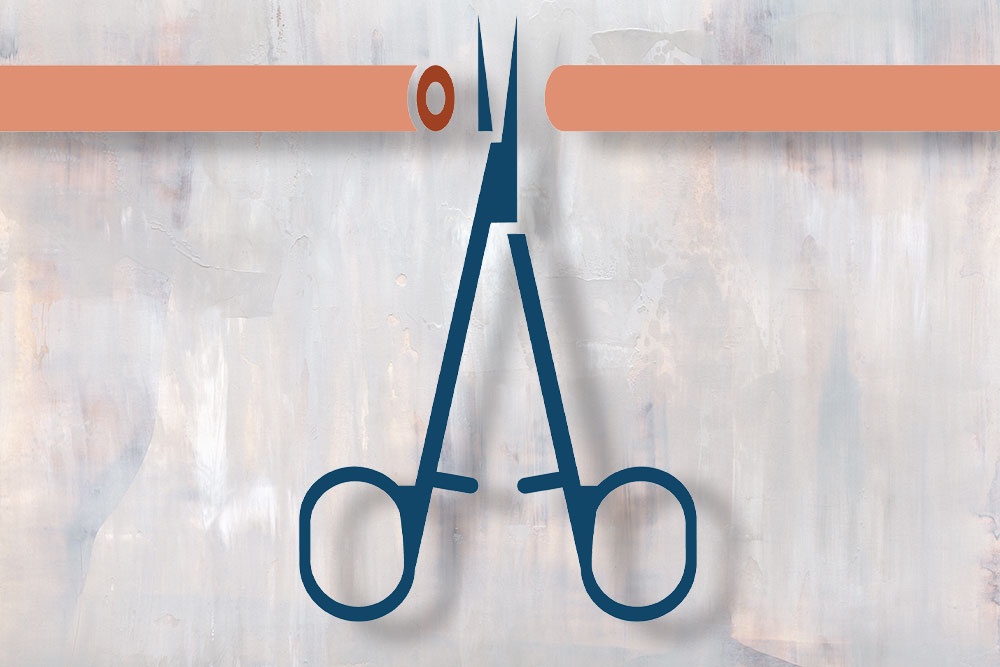A Case for Choosing Vasectomy

How a simple snip makes birth control easy.
By Lauren Lisle
Making the decision to not have additional children—or any children at all—is very personal, but it’s only part of the equation. How you choose to prevent pregnancy also requires consideration of the potential consequences and how they may affect your life.
In large part, the responsibility to avoid unwanted pregnancy has fallen on the shoulders of women through various means of contraception, many of which are hormonal methods that produce undesirable side effects, including weight gain, mood changes, and decreased sexual desire.
A 2018 report from the Centers for Disease Control and Prevention (CDC) states that nearly 47 million women aged 15-49 in the U.S. use a form of contraception, and nearly all women use contraception at some point in their lifetime. By contrast, approximately 500,000 men of reproductive age elect to have vasectomies each year in the U.S., though the procedure is considered the most effective method of contraception outside of abstinence, and the only other male option is to use a condom, which is only effective about 85% of the time—so what gives?
Fear, misconceptions, and toxic cultural beliefs on what defines masculinity all play into apprehension toward vasectomy. While it’s understandable why someone would feel uncomfortable with the sterilization procedure, it shouldn’t be considered off-limits because of societal expectations or archaic gender roles. Additionally (and more importantly), when it comes to sterilization specifically, procedures for men and women are not equal.
According to the American College of Obstetricians and Gynecologists (ACOG), male sterilization is considered safer and less invasive than female sterilization (which includes surgical procedures tubal ligation, bilateral salpingectomy, and essure sterilization). What’s more, the ACOG states there’s no increased risk of ectopic pregnancy if a vasectomy fails. Women, on the other hand, have an increased risk of developing an ectopic pregnancy after tubal surgery, making vasectomy an important option for women’s health care.
What is a Vasectomy?
A vasectomy is a minor surgery that blocks sperm from reaching a man’s semen. While the semen still exists, it’s void of sperm and therefore unable to cause pregnancy. The remaining sperm cells stay in the testicles and are eventually absorbed by the man’s body.
During the procedure, a trained urologist cuts and seals the small tubes in the scrotum (vas deferens tubes) that carry sperm. This can be done by making one incision in the middle of the scrotum or by making two separate cuts, one on each side.
Vasectomy is an outpatient surgery that can be performed in a doctor’s office, hospital, or clinic in less than 30 minutes and carries low risk of complications or side effects. It takes about three months after the procedure for vasectomy to become effective, at which time the patient has a follow-up appointment with the urologist to test the semen to ensure it was successful and the semen is sperm-free. Until then, it’s advised to use an alternate method of birth control. Additionally, patients should be aware that vasectomies do not prevent sexually transmitted infections and should always use proper precautions.
Even though the process sounds simple, it’s still a surgical procedure that takes time to consider. Speaking with others who have gone through the process is a great way to gain insight and possibly some peace of mind.
What Former Patients Have to Say
One man willing to undergo “the snip” was my husband. After four healthy, perfectly unplanned pregnancies, he promptly made an appointment with a highly recommended urologist and has become a bit of a spokesman on the subject since his procedure last year.
“I felt it was a duty of mine considering all the responsibilities [my wife] had to shoulder with all four pregnancies, deliveries, and collective years of physical and emotional recovery,” he explains. “After many unplanned pregnancies, getting a vasectomy was the one planned, proactive decision I could make to finish this chapter in our life. In short, I have no regrets, and I would absolutely do it again.”
But it’s not only reproductively healthy married men with children who are choosing to have vasectomies. Since the overturn of Roe. v. Wade in June, more men have sought vasectomies as access to abortion has been restricted in certain states, and the future availability of temporary or permanent contraception is unclear.
Trevor, a 32-year-old male living in Atlanta, is both unmarried and child-free and chose to have a vasectomy pre-overturn, though he acknowledges he felt restrictions on reproductive health care were only a matter of time.
“Federal protections on abortion services have been precarious for years now, which was a consideration,” he says, adding, “I’ve certainly relied on my partners in the past to take on the heavy-duty hormonal burdens of birth control. If I know in my heart that I don’t want children, then there aren’t very many good arguments for putting my partner through that.”
He goes on to explain that getting the vasectomy has allowed him to live a less stressful life without the looming anxiety of an accidental pregnancy, and when it came to the actual procedure, it wasn’t even all that bad.
“The process was pretty simple. I went in for a consultation and booked the procedure for the end of that month. I didn’t feel any pain except for the local anesthesia shots, and it was over in about 10-15 minutes,” he says.
Recovery for Trevor was also pretty standard, requiring a week off from work due to the physical demands of his job. And even though his procedure was not fully covered by his insurance (totaling around $500 out of pocket), it’s important to note that vasectomy is much more cost-effective than other forms of birth control.
Misconceptions About Vasectomy
Many men have confusion or worries surrounding the effects of vasectomies. Here are some important unfound concerns to note about the procedure.
Vasectomies have a sliding success rate.
Vasectomies have a long-term success rate of over 99%, and approximately only 1-2 women out of every 1,000 will get pregnant within the first year after the procedure. These pregnancies are often linked to cases where patients do not participate in routine follow-up testing to ensure the procedure was successful.
You don’t need to have your semen tested following a vasectomy.
All patients need to adhere to their provider’s recommendations for semen testing following the procedure, usually after a certain number of weeks or ejaculations. Without official confirmation, it’s impossible to know for certain whether or not the patient’s remaining semen is sperm-free and able to cause pregnancy.
Vasectomies affect sexual performance.
According to the Mayo Clinic, a vasectomy “won’t affect your sex drive or your masculinity in any way other than preventing you from fathering a child. Men have even reported higher sexual satisfaction after a vasectomy.”
There’s an increased risk of certain cancers after sterilization.
In the past, there was concern over a possible tie between vasectomy and prostate cancer or testicular cancer, but thankfully, there’s no proven link.
Post-vasectomy recovery will be long and painful.
The good news is patients can head home to rest immediately after the procedure with minimal (not terrible) pain, and the rate of long-term pain requiring treatment is estimated to be approximately 0.1% of all vasectomies. Taking over-the-counter pain medication such as ibuprofen and using ice packs on the affected area are standard forms of at-home care, along with avoiding physical labor or exercise for one week. Additionally, most people only need a few days to recover after their vasectomy before returning to work.
Vasectomies are reversible … sort of.
This one is a bit more complicated, but the general rule of thumb is to choose vasectomy under the pretense that it is permanent birth control. While vasectomy reversal is possible, it’s not guaranteed, and the costly procedure is often not covered by insurance.
If you book a consultation for a vasectomy, expect your provider to ask questions about your current wants and future desires surrounding children, as it’s their responsibility to make sure potential patients understand that choosing vasectomy is a set-in-stone plan. My husband, for example, was asked if he had ever thought about becoming a dad one day, to which he informed the urologist he was already the father of three, and soon-to-be four, children, which sealed the deal without further questioning.
Why Sterilization is Important in Today’s World
According to the CDC, 45% of overall pregnancies in the U.S. are unintended, but some groups experience even higher numbers, particularly women who: are Black, are between 18-24 years old, have lower incomes, did not complete high school, and cohabitate without getting married.
To reduce the number of unintended pregnancies, the CDC says that knowledge of correct and consistent use of contraceptives, and access to contraception that includes the full range of methods, including male and female sterilization, are paramount.
Sterilization is also crucial because of the continued restrictions being placed on abortion services across the nation, in part because it prevents unplanned pregnancy, and because as an effective contraceptive, it also helps reduce the number of abortions, according to the ACOG. This is not only true of abortions in the U.S., but successful use of contraception could also result in 4.5 million fewer abortions worldwide.
While vasectomy is an under-utilized method of birth control today, it’s still more effective than other forms of long-term contraception. If you and your partner have decided to not have future children, male sterilization is a great way to protect each other (and potential future partners) from unwanted pregnancy.








